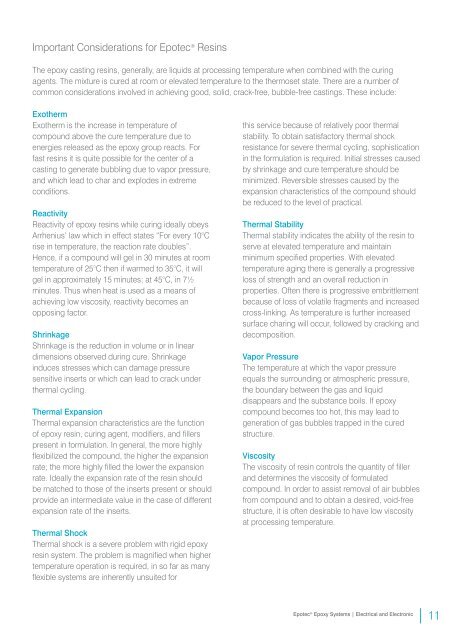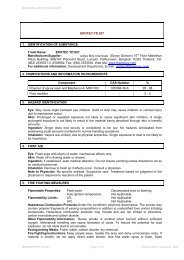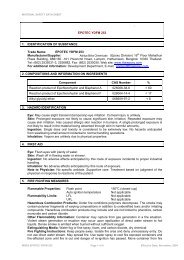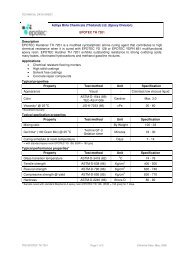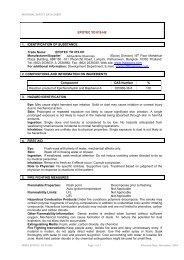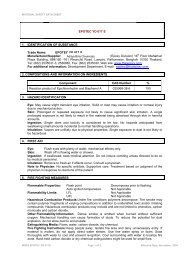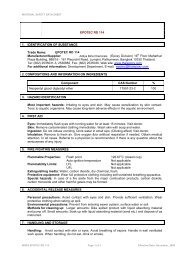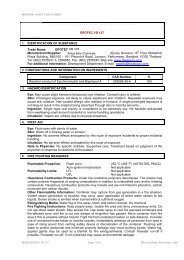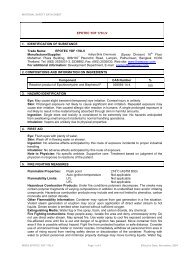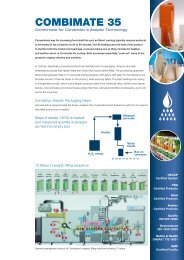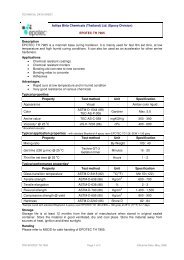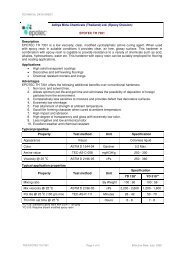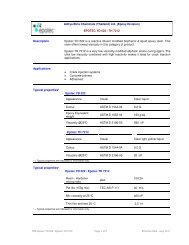Epotec - electrical and electronic applications - Aditya Birla Chemicals
Epotec - electrical and electronic applications - Aditya Birla Chemicals
Epotec - electrical and electronic applications - Aditya Birla Chemicals
You also want an ePaper? Increase the reach of your titles
YUMPU automatically turns print PDFs into web optimized ePapers that Google loves.
Important Considerations for <strong>Epotec</strong> ® Resins<br />
The epoxy casting resins, generally, are liquids at processing temperature when combined with the curing<br />
agents. The mixture is cured at room or elevated temperature to the thermoset state. There are a number of<br />
common considerations involved in achieving good, solid, crack-free, bubble-free castings. These include:<br />
Exotherm<br />
Exotherm is the increase in temperature of<br />
compound above the cure temperature due to<br />
energies released as the epoxy group reacts. For<br />
fast resins it is quite possible for the center of a<br />
casting to generate bubbling due to vapor pressure,<br />
<strong>and</strong> which lead to char <strong>and</strong> explodes in extreme<br />
conditions.<br />
Reactivity<br />
Reactivity of epoxy resins while curing ideally obeys<br />
Arrhenius’ law which in effect states “For every 10°C<br />
rise in temperature, the reaction rate doubles”.<br />
Hence, if a compound will gel in 30 minutes at room<br />
temperature of 25°C then if warmed to 35°C, it will<br />
gel in approximately 15 minutes; at 45°C, in 7½<br />
minutes. Thus when heat is used as a means of<br />
achieving low viscosity, reactivity becomes an<br />
opposing factor.<br />
Shrinkage<br />
Shrinkage is the reduction in volume or in linear<br />
dimensions observed during cure. Shrinkage<br />
induces stresses which can damage pressure<br />
sensitive inserts or which can lead to crack under<br />
thermal cycling.<br />
Thermal Expansion<br />
Thermal expansion characteristics are the function<br />
of epoxy resin, curing agent, modifiers, <strong>and</strong> fillers<br />
present in formulation. In general, the more highly<br />
flexibilized the compound, the higher the expansion<br />
rate; the more highly filled the lower the expansion<br />
rate. Ideally the expansion rate of the resin should<br />
be matched to those of the inserts present or should<br />
provide an intermediate value in the case of different<br />
expansion rate of the inserts.<br />
Thermal Shock<br />
Thermal shock is a severe problem with rigid epoxy<br />
resin system. The problem is magnified when higher<br />
temperature operation is required, in so far as many<br />
flexible systems are inherently unsuited for<br />
this service because of relatively poor thermal<br />
stability. To obtain satisfactory thermal shock<br />
resistance for severe thermal cycling, sophistication<br />
in the formulation is required. Initial stresses caused<br />
by shrinkage <strong>and</strong> cure temperature should be<br />
minimized. Reversible stresses caused by the<br />
expansion characteristics of the compound should<br />
be reduced to the level of practical.<br />
Thermal Stability<br />
Thermal stability indicates the ability of the resin to<br />
serve at elevated temperature <strong>and</strong> maintain<br />
minimum specified properties. With elevated<br />
temperature aging there is generally a progressive<br />
loss of strength <strong>and</strong> an overall reduction in<br />
properties. Often there is progressive embrittlement<br />
because of loss of volatile fragments <strong>and</strong> increased<br />
cross-linking. As temperature is further increased<br />
surface charing will occur, followed by cracking <strong>and</strong><br />
decomposition.<br />
Vapor Pressure<br />
The temperature at which the vapor pressure<br />
equals the surrounding or atmospheric pressure,<br />
the boundary between the gas <strong>and</strong> liquid<br />
disappears <strong>and</strong> the substance boils. If epoxy<br />
compound becomes too hot, this may lead to<br />
generation of gas bubbles trapped in the cured<br />
structure.<br />
Viscosity<br />
The viscosity of resin controls the quantity of filler<br />
<strong>and</strong> determines the viscosity of formulated<br />
compound. In order to assist removal of air bubbles<br />
from compound <strong>and</strong> to obtain a desired, void-free<br />
structure, it is often desirable to have low viscosity<br />
at processing temperature.<br />
<strong>Epotec</strong> ® Epoxy Systems | Electrical <strong>and</strong> Electronic<br />
11


